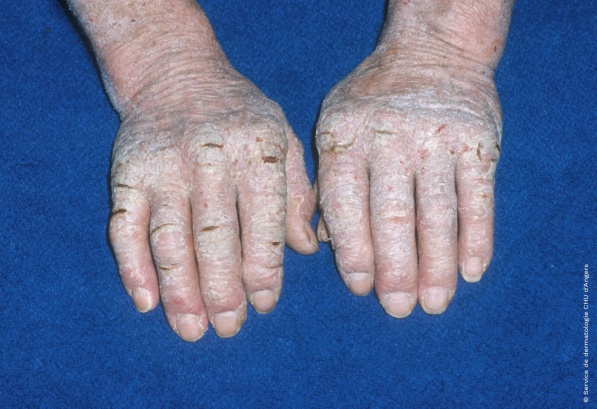

Eczema on the hands

Eczema can affect any part of the hands, from the palms and fingertips to the back of the hands, or all these areas simultaneously. Eczema is especially bothersome when it affects this highly sensitive, and more visible, part of the body. How can you get soothing relief? The first step is to determine whether it is linked to an allergy, an irritation or to atopic skin. Sometimes, a combination of these causes is responsible.
Contact or atopic eczema, the affected areas
In the case of contact eczema, the affected area is the one that has been in contact with the triggering agent. The hands are often among the contact areas since they carry the product.
In the case of atopic eczema, the affected areas are numerous and vary with age. Before the age of 2, atopic eczema appears more on the arm than on the hands. The hands, wrists, elbow creases, and fingers are common locations from the age of 2 up to adulthood. Atopic dermatitis can also appear on the neck, face, feet, ankles, and behind the knees.
Allergic eczema on the hands
Because we are constantly using our hands to touch, handle and carry things, they are exposed to a wide range of products and substances, some of which can cause allergies. Indeed, eczema on the hands is often a case of allergic eczema, or contact eczema. But it could also be an irritation.
Clinical aspects
Signs of acute eczema include redness accompanied by swelling and oozing. Most often, however, eczema on the hands develops as a chronic condition presenting as either acute flare-ups or severe, stubborn eczema characterized by a thickening of the skin and large, particularly painful scales and cracks. In some cases, people are unable to work and take sick leave as a result of the condition.
The causes
Inflammation can result from contact with either an object, like a ring for example, or a product, like a cream.
The following are relatively common triggers for allergic reactions in the hands and fingers:
- maintenance products: detergents, dishwashing liquid, cleaning products
- cosmetics and cleansing products: shower gels, wet wipes, nail polish
- jewelry and metal objects: keys, coins, rings, etc.
- accessories: mobile phones
- textiles: gloves
- other: ink, paint, polish, dyes, etc.
The list is long, because, as we go about our leisure, household and professional activities, our hands come into contact with an infinite number of objects and products that contain potential allergens. In fact, you are allergic not to the object itself but rather to the allergen found in the object (nickel, chromium, cobalt, formaldehyde, etc.).
What should you do?
You must identify the triggering agent in order to avoid it in your daily activities. The same agent can be found in a variety of products and objects, making it difficult at times to find the culprit all on your own.
A dermato-allergologist will help you investigate by asking detailed questions and carrying out allergy tests to identify the allergen. They will also provide you with a topical treatment to soothe painful eczema.
You may find that you have already touched the suspected product several times in the past without ever having had a reaction. This is possible: allergies are never triggered upon the first exposure!
Is the allergy connected to your job?
Bakers, florists, hairdressers or even construction workers: some professions, especially those involving more manual labor, require workers to handle more substances that contain allergens. If your job exposes you to certain products on a regular basis, you may have work-related contact eczema.
Over half of all hand eczema cases are work related.
Atopic eczema on the hands
For atopic eczema in adults, the hands and face are the most commonly affected areas of the body. Atopic eczema can also affect children and infants, but it tends to appear in other areas.
When atopic eczema affects the hands and face, however, the possibility of an accompanying contact allergy should be explored.
Hypersensitivity to the environment
This type of eczema is not caused by an allergic reaction. It affects people with atopic skin, a genetic predisposition to hypersensitivity to the environment (which may also manifest as asthma for example).
What causes flare-ups?
Atopic eczema is chronic and presents as alternating periods of flare-ups and remission. Flare-ups can be triggered or aggravated by various combined factors such as climate, scratching, sweat, and certain foods.
Is it caused by stress?
Stress can be a triggering or aggravating factor for flare-ups, but it is never the cause of atopic eczema. Rather, it is caused by a condition known as “atopy”. This type of eczema is therefore not “all in your head” or “psychosomatic”, contrary to what you too often hear.
Dyshidrotic eczema
Shortened to dyshidrosis, this term is used to describe a certain clinical aspect of eczema on the hands and feet.
Causes of dyshidrosis
This type of eczema can be a case of allergic eczema or atopic eczema. In some cases, however, the cause remains unknown. The following are the most common triggering or aggravating factors for this type of eczema:
- sweat
- contact allergies (nickel, cobalt)
- stress
- smoking
Irritative eczema
Irritative eczema often affects the hands and is aggravated by excessive washing or a humid work environment. It most often appears in the palms and on the fingers, especially the finger pads.
“Burning” eczema
The skin is dry and often develops very painful cracks, especially around the fingernails. Skin can become red, but without any vesicles or oozing. It burns more than it itches. The condition is thus painful and makes it difficult to use your hands.
What are the causes of irritative eczema?
Irritative eczema is associated with the deterioration of the skin’s protective barrier known as the “hydrolipidic film” (our skin’s natural protective film made up of water and oily substances). Overly harsh detergents, excessive washing with soap, prolonged exposure to humidity, and the use of degreasing agents alter this film and cause irritation.
Certain professions are of particular concern: hospital workers, cleaning staff, hairdressers, etc.
Cold temperatures are also an aggravating factor for this type of irritation.
Irritated skin is more permeable, allowing allergens to penetrate the surface more easily. Thus, irritative eczema may be further complicated by allergic eczema.
How to care for hands affected by irritant eczema
It is recommended to wear gloves and to apply protective creams regularly, both to treat as well as to prevent the condition.
What types of cream should you use for hand eczema?
Treat flare-ups by applying a topical corticosteroid (cortisone cream) as a localized treatment. It is also important to repair damaged skin at the same time with a hydrating product (emollient). Specific products are available for the hands.
Protecting your hands is also key
Creams are important, but creams alone are not enough. Wearing gloves is recommended for washing dishes, cleaning, or even peeling vegetables. Put simply, gloves are recommended for all manual tasks.
Cleaning detergents, degreasing agents and soaps are irritants and can make eczema worse.
What hygiene routine should be followed to care for irritated hands?
In case of eczema on the hands, use a gentle, soap-free cleanser such as an oil, cleansing cream, or dermatological bar to wash your hands. Dry them gently with a clean towel. Apply a suitable moisturizing cream after each wash. Be careful not to apply cream to inflamed areas. If you experience tingling or burning when applying the cream, it is not suitable.
In winter, protect your hands from the cold with warm gloves. For dishwashing or cleaning, use clean gloves that are effective against chemical aggressions. If your hands are too irritated, consult a doctor to establish an appropriate treatment.
Reducing hand eczema related to excessive sweating
To reduce the spread of a hand eczema flare-up due to excessive sweating, avoid taking showers that are too hot. The temperature should be below 34°C (93°F) and do not stay under the water for more than 5 minutes. After showering, dry your skin well with a clean towel by patting to reduce the sensation of moisture.















